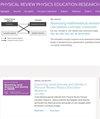Evaluation of a new teaching-learning sequence on the particulate nature of matter using crystal structures
IF 3.6
2区 教育学
Q1 EDUCATION & EDUCATIONAL RESEARCH
Physical Review Physics Education Research
Pub Date : 2024-07-29
DOI:10.1103/physrevphyseducres.20.020104
引用次数: 0
Abstract
Although there has been extensive research on students’ understanding of the particulate nature of matter (PNM), there is still a lack of research on contexts that can be used to teach this challenging topic. In a previous design-based research study, the authors developed a teaching-learning sequence (TLS) on the PNM in the context of crystal structures based on 40 student interviews using the method of probing acceptance. Data suggested that salt and snow crystals form an effective context for learning the concept of emergence and therefore gaining a better understanding of the PNM. To test whether the TLS also promotes students’ use of the PNM in a realistic classroom setting, a proof of principle study was conducted. In six eighth-grade classes in Vienna, students’ use of the PNM was assessed with a pretest before they were taught the TLS during four lessons. After the intervention, students were given a post-test. Open-ended questions were coded using evaluative qualitative content analysis so that quantitative analysis could be applied. T-tests comparing the means of students’ scores on both tests show significant improvements in students’ use of the PNM in the post-test. The context of crystal structures seems to be helpful to students, as most of them use the PNM when asked about crystal formation. In addition, in the post-test, students more often accepted the idea of empty space between particles and associated particle motion with temperature. However, when asked about phase changes, most students remained in a continuous conception of matter.

利用晶体结构评估关于物质微粒性质的新教学序列
尽管关于学生对物质的微粒性质(PNM)的理解已经有了广泛的研究,但仍然缺乏可用于教授这一具有挑战性课题的情境的研究。在之前的一项基于设计的研究中,作者根据对 40 名学生的访谈,采用探究接受的方法,在晶体结构的背景下开发了一个关于微粒性质的教与学序列(TLS)。数据表明,盐和雪的晶体构成了学习 "涌现 "概念的有效情境,因此可以更好地理解 PNM。为了检验 TLS 是否也能促进学生在现实课堂环境中使用 PNM,我们进行了一项原理验证研究。在维也纳的六个八年级班级中,在四节课上教授 TLS 之前,先对学生使用 PNM 的情况进行了预测试评估。干预结束后,对学生进行了后测。采用评价性定性内容分析法对开放式问题进行编码,以便进行定量分析。比较学生在两次测试中的平均得分的 T 检验表明,在后测试中,学生对 PNM 的使用有了显著提高。晶体结构的情境似乎对学生很有帮助,因为大多数学生在被问及晶体形成时都会使用 PNM。此外,在后测试中,学生们更多地接受了粒子间存在空隙的观点,并将粒子运动与温度联系起来。然而,当问及相变时,大多数学生仍然停留在物质的连续概念上。
本文章由计算机程序翻译,如有差异,请以英文原文为准。
求助全文
约1分钟内获得全文
求助全文
来源期刊

Physical Review Physics Education Research
Social Sciences-Education
CiteScore
5.70
自引率
41.90%
发文量
84
审稿时长
32 weeks
期刊介绍:
PRPER covers all educational levels, from elementary through graduate education. All topics in experimental and theoretical physics education research are accepted, including, but not limited to:
Educational policy
Instructional strategies, and materials development
Research methodology
Epistemology, attitudes, and beliefs
Learning environment
Scientific reasoning and problem solving
Diversity and inclusion
Learning theory
Student participation
Faculty and teacher professional development
 求助内容:
求助内容: 应助结果提醒方式:
应助结果提醒方式:


